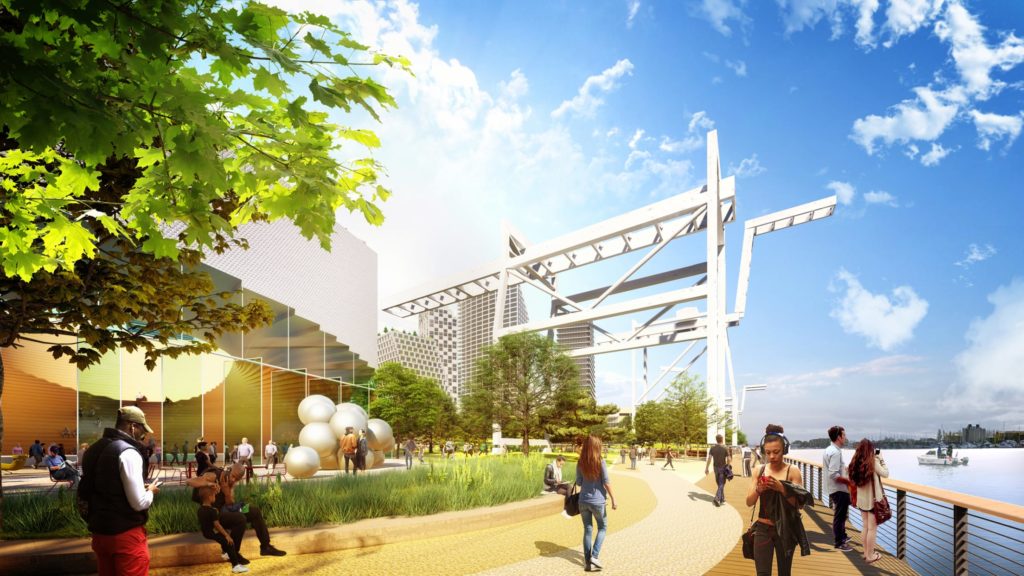
A new Oakland A’s ballpark plan cleared a big hurdle late yesterday after the Oakland City Council approved a 3,500-page environmental impact report (EIR), moving the Howard Terminal waterfront project along.
The new ballpark EIR had already been approved unanimously by the Oakland Planning Commission in January, and while passage of the full report was expected, there was always the chance it could be delayed. But the report was approved on a 6-2 vote.
The A’s have proposed a downtown Howard Terminal waterfront development featuring $12 billion in private investment, including a billion dollars for a new 35,000-capacity ballpark to replace the Oakland-Alameda County Coliseum as the team’s home. The development would also include 3,000 units of housing, as well as 1.5 million square feet of office space, 270,000 square feet of retail space, a 400-room hotel, 18 acres of parkland and an estimated $450 million in community benefits. It would represent a massive makeover of the Oakland waterfront, transforming a industrial site into a mixed-use development.
The EIR is mandated by California law to document potential environmental impacts and how the city and developer plan on mitigating them. It was issued as a draft in 2021 and was subject to review and comments since. In a statement, Oakland Mayor Libby Schaaf hailed the progress:
“Tonight’s vote by the City Council was a historic moment for Oakland’s future. The companion resolution by Councilmembers Bas, Kaplan, and Kalb ensures that all Oaklanders will benefit from the proposed waterfront ballpark district, and that a world-class development with 18 acres of new public parks, 3,000 units of housing – including new affordable housing – will get built with the most sustainable and highest environmental standards on our waterfront.
Now that the Final Environmental Impact Report has been certified, the floor is set for negotiating robust community benefits that our residents demand and deserve, as well as the final development agreement.”
As Schaaf noted, the two sides still need to work out a deal on affordable housing and community benefits, and an infrastructure funding mechanism needs to be discussed with the city and Alameda County. The county had tentatively committed to an Enhanced Infrastructure Financing District (EIFD) to fund infrastructure upgrades in the Howard Terminal area. In the nonbinding vote, the county approved the district. The EIFD would benefit all businesses in the general area, not just the new A’s ballpark, but obviously the new development would be the biggest beneficiary of the fund. That nonbinding commitment needs to become permanent.
There is also plenty of other site work to be tackled as well, as the A’s development team will need to prepare mitigation plans for the likes of the San Francisco Bay Conservation and Development Commission and Department of Toxic Substances Control.
Rendering courtesy Oakland Athletics.
RELATED STORIES: Oakland Planning Commission approves A’s ballpark EIR; A’s reportedly looking at Tropicana for Vegas ballpark site; A’s succeed in launching bidding war in Las Vegas; A’s ask for feedback on Las Vegas Strip ballpark; Alameda County approves Oakland waterfront ballpark plan; Oakland urges Alameda County support of new ballpark tax district; Alameda County to discuss Athletics ballpark Oct. 26; A’s to narrow field of Vegas sites after playoffs; three sites cited by locals; Alameda County to A’s: Slow down, cowboy; A’s brass resumes Vegas runs, continues talks with Oakland; Oakland, A’s to resume ballpark talks; State funding on tap for new Oakland ballpark?; A’s: Maybe we can work with Oakland on new ballpark terms; Oakland presents term sheet for new ballpark; A’s immediately reject it
